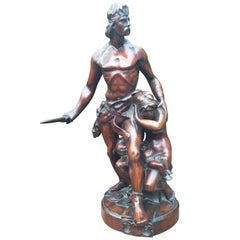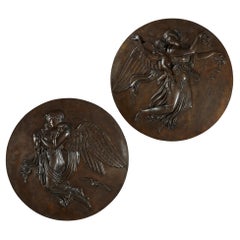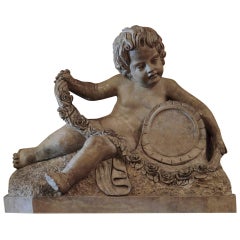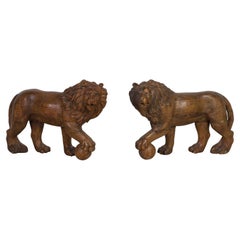Europe - Sculptures
2
234
4
1
to
12
239
433
239
236
236
2,655
2,591
1,538
473
430
349
333
239
153
149
111
99
75
49
34
30
27
13
21
141
72
5
20
11
30
2
2
1
1
2
1
Height
to
Width
to
106
99
95
72
33
232
93
62
19
17
4
3
2
2
2
Item Ships From: Europe
Style: Neoclassical
One of a Kind Antique Carved Wood Group Statue Sculpture by Emile Boisseau
Located in Lisse, NL
Unique 19th century French wooden sculpture.
This large and figural group is titled 'La Defense Du Foyer' which translates as 'the protection of the spous.' This impressive sculpture is in good and original condition and this ripped hunter defenitely looks ready to fight off anyone or anything threatening his spous.
This sculpture is attributed to Emile Andre...
Category
Late 19th Century French Neoclassical Antique Europe - Sculptures
Materials
Wood
Large Pair of Circular, Patinated Bronze Relief Plaques of Night and Day
Located in London, GB
A pair of patinated bronze antique plaques of Night and Day
French, Late 19th Century
80cm in diameter, 5cm in depth
Modelled after Bertel Thorvaldsen's iconic 'Night and Day' relie...
Category
Late 19th Century French Neoclassical Antique Europe - Sculptures
Materials
Bronze
Gilt and Patinated Bronze Group Dancers by S. Loveque
Located in London, GB
The intertwined dancing couple wearing neoclassical clothing, accompanied by a child putto, signed S. Loveque.
Category
Early 20th Century French Neoclassical Europe - Sculptures
Materials
Bronze
18th Century Sculpted Verona Marble Putto
Located in Vosselaar, BE
Depictions of young angelic boys are also known as putti, or putto for a single one. Since the 17th century on they remained popular and are found in various forms. Perhaps the most known version is Cupid. Looking at their attributes time periods can be narrowed down. In this example we see a rose Guirlande and a medaillon which are typical for the late 18th- early 19th century. The Rosso Verona Marble...
Category
Late 18th Century Italian Neoclassical Antique Europe - Sculptures
Materials
Marble
"Flora" and "Grapevine", a French 19th Century Pair of Putti
Located in Saint-Ouen, FR
"Les Enfants de Bacchus"
A French 19th century Charming Pair of Putti
Natural wood hand carved in full round
One symbolizing Flora, the other one the Grapevine.
Resting on circular...
Category
1870s French Neoclassical Antique Europe - Sculptures
Materials
Marble
Pair of C19th Carved Medici Lions
Located in Shipston-On-Stour, GB
C19th pair medici lions in carved wood, at opposing stances with heads turned to sinister and dexter, with one paw on a ball. Circa 1830.
30 3/4" wide x 9.5" deep x 21.05" high
Category
1820s Italian Neoclassical Antique Europe - Sculptures
Materials
Pine
”Child Portrait” Marble and Bronze, Spain, 19th Century
Located in Madrid, ES
"Girl with flowers on a basket". Sculpture in white marble and bronze, on base, Spain, 19th century.
The pedestal, in the shape of a column with a smooth shaft, elevates the sculpture and highlights it with its elegance of lines and lack of exaggerated decorative elements (aside from some moldings in what would be the capital and the marbled marble change in the upper piece, on which the sculpture is located). The figure of the girl, carved in a white marble of great quality, is sitting, looking towards the distance, and with a bouquet of flowers in her arms and a medal hanging from a cord around her neck. When sitting on a basket with flowers the figure is softened, in addition to enhancing it with the chromatic contrast existing between the flowers and the basket (patinated bronze) and the figure. The hair of the girl, with a pictorial waves without a powerful chiaroscuro, contrasts with the detail of the dress, perfect both in the ruffles of the neck and in the embroidery of the fabric and with which, in addition, an "informal" touch has been added to show fallen a strait and the skirt wrinkled. This lack of formality fits perfectly with the theme, and is slightly accentuated by presenting the figure with socks (or stockings, dropped) and without shoes. The realism of the face (attenuated with a slight idealization) suggests that it is a child portrait.
The pictorial treatment of the figure and the roses relate it to artistic approaches that emerged during the 19th century and with a certain aesthetic and skill level. Stylistically, it is possible to relate it to the environment and the influence of two key figures of 19th-century Spanish art for their invoice, traits, technical mastery and originality: Agustín Querol...
Category
19th Century Spanish Neoclassical Antique Europe - Sculptures
Materials
Marble, Bronze
Recently Viewed
View AllMore Ways To Browse
Seguso Family
Italian Carved Giltwood Stands
Art Deco Bookshelf
18th Century Jade
Winged Sphinx
Bc Rich
Chinoiserie Turquoise
Neoclassical Decorative Element
Sea Things
Son Hermes
Mary Statue
Vintage Brass Made In India
Carved Ebony Heads
Classical Bas Reliefs
Antique Marble Auctions
Cast Iron Heart
Naked Statue
Orb On Stand





